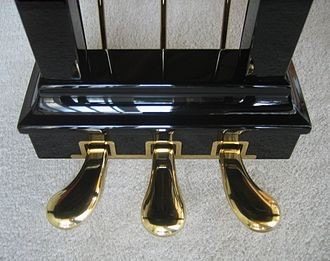Right Pedal Function
Let’s start with the rightmost pedal
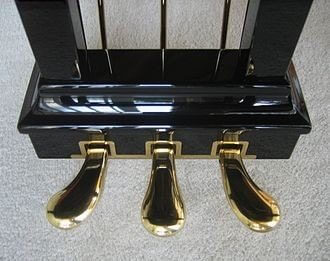
Many people probably know that when you press down the right pedal The sound will be prolonged
So why does the sound get prolonged?
From the piano’s structure, there is a “damper” above each string

(The black objects in the image are the dampers)
The so-called “damper” is used to stop the strings from vibrating
Without this damper, when the piano hammer hits the string, the string would continue to vibrate for a period of time before stopping
(Which means the sound would continue for a period before stopping)
And the rightmost pedal of the piano lifts “all” dampers away from the strings, preventing the dampers from working, thus allowing the sound to be prolonged

(The above image shows the situation when the right pedal is pressed, with the dampers lifted away from the strings)
Although we call them “pedals”, initially the “pedals” were actually controlled by hand, which was very inconvenient for pianists as it was difficult to free their hands from the keys to control the “pedals”
Later, a type of “pedal” controlled by the knee (thigh) appeared
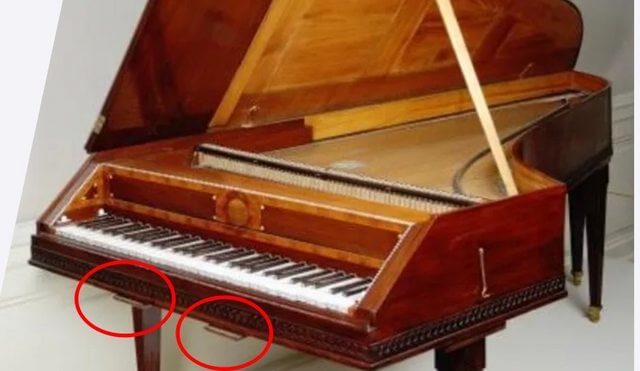
(In the above image, there are two protruding wooden boards under the keys. When the right wooden board is pushed up with the knee, the dampers will lift away from the strings, allowing the sound to be prolonged - this is the predecessor of the modern piano’s right pedal)
Mozart first encountered this type of piano in 1777, and wrote a piano sonata (Opus KV 311), where at the end of the second movement, the left hand span is extremely wide, almost reaching two octaves

(The distance of one octave on the keys is about 15 centimeters, two octaves is almost 30 centimeters. To simultaneously press the lowest and highest notes with the left hand is very difficult for normal people, this is when the pedal is needed to sustain the sound)
Then in the late 18th and early 19th centuries, the pedals were moved to the foot position like on modern pianos
Middle Pedal Function
The middle pedal actually has different functions on different pianos
Above we mentioned that the right pedal can lift “all” dampers away from the strings, allowing all piano sounds to be sustained
The middle pedal can only sustain “specific” notes, specifically the notes that “have already been played”
For example
When you play Do Mi Sol, then press the middle pedal, only Do Mi Sol will be sustained, other notes will not be affected
Usually this type of specific note sustain pedal is only found in grand pianos
Left Pedal Function
Many people probably also know that the left pedal is also called the “soft pedal”
So how does the pedal make the piano sound softer?
Normally, when the piano hammer strikes the strings, it hits all strings simultaneously (three strings for high notes/two strings for middle-low range/one string for lowest range)
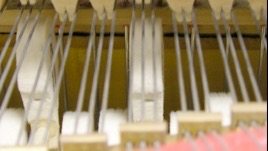
![]()
(The above image shows the situation when the hammer strikes the piano normally.)
If we want to make the sound softer, in addition to controlling the force, we can also press the left pedal.
When we press the left pedal, the entire piano hammer moves to the right.
!!Only the hammer moves to the right, the strings do not move with it!!
As it moves to the right, the number of strings that can be struck decreases, which means the sound will be softer.
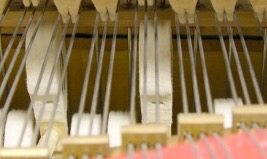
![]()
(The above image shows the situation after pressing the left pedal, where only two strings can be struck simultaneously instead of the original three strings.)
This soft pedal began to become popular in the late 18th century, and we can find markings for the soft pedal in many of Beethoven’s (1770-1827) works.
For example, Beethoven marked in the score:
Mit einer Saite - sul una corda
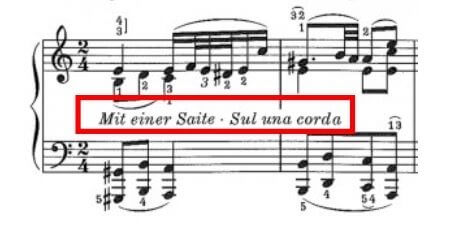
This means “using one string,” which means pressing the soft pedal allows the hammer to strike only one string.
However, this is another issue. In modern pianos, when the left soft pedal is pressed, the striking condition usually changes from the original three strings to two strings, and it cannot change to the “one string” as written in the score.
In fact, pianos from the late 18th to early 19th century could determine the number of strings struck by the depth of the pedal.
The deeper you press, the more the hammer moves to the right, allowing it to strike only one string.
If you press a little shallower, it can strike only two strings.
That is why Beethoven marked in the score
poco a poco due ed allora tre corde

This means “gradually two strings and then all three strings.”
In other words, from originally one string, gradually releasing the left foot’s soft pedal, returning to the original state of three strings.
Later, some musicians wrote in German
mit Verschiebung
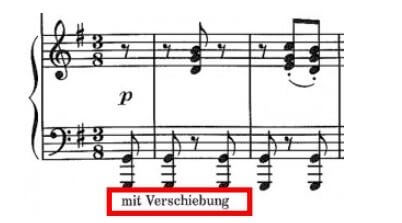
Verschiebung means shifting, moving, which refers to moving the hammer.
The use of piano pedals is a double-edged sword; when used well, it enhances the tone, but when used poorly, it can make the sound very noisy. There are many factors to pay attention to, such as different venues, different pianos, humidity, etc., all of which can affect the sound produced by the piano.
Usage Scenarios
Let me provide some examples of how the three pedals are used during performance.
The most commonly used right pedal sustains all the notes when pressed, so the more notes played while pressing, the more the sound becomes muddled. To keep the sound clean, I change my foot position very frequently, even more than indicated in the score.
The middle pedal sustains a single note, usually used to sustain the bass in the left hand, while the sustain in the right hand is not as obvious.
My method is that if I want to sustain a note, I will press the middle pedal after playing that note, and then I will also press the right pedal to handle the legato in the right hand.
I find that using the middle pedal and the right pedal together is very suitable for Debussy’s pieces, such as Clair de lune. In measure 10, there is a sustained bass note for an entire measure, but the left hand has other notes to manage, making it impossible to hold the long note continuously. Some people handle this by pressing the right pedal for the entire measure, but this can cause the sound to become muddy.
At this time, the middle pedal is very useful. I will first play that long note, then keep the middle pedal pressed with my left foot until that long note ends, while simultaneously using my right foot to manage the other notes with the right pedal. This way, the sound will be very clean.
The left pedal softens the sound; when the left foot is pressed, the entire keyboard shifts to the right. In one section of Brahms’ op118 No.2, it is clearly marked to use the left pedal, indicated by the term una corda.
When I press the left pedal to soften the sound, I also use the right pedal to manage the continuity of the sound.
